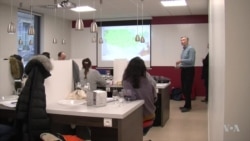Yixuan Hao swirls the sparkling red in her glass and dips nearer to sniff. Throughout this frigid afternoon, she has been smelling and tasting wines from sunnier climates: Australia, New Zealand, South Africa, California. Perhaps soon, sooner than many people think, students like herself learning the wine trade here in Burgundy, will be sipping vintages from another New World upstart: China.
“It’s like a learning curve,” says Hao, 23, who comes from Xinjiang province, China’s biggest producer of wine grapes. “You need to learn from others who know better. But we’re trying to develop our own style, rather than copy the Bordeaux and the Burgundies.”
Welcome to the School of Wine and Spirits Business in Dijon, part of the Burgundy School of Business, where nearly one-third of the student body is from China. The nation that now dominates manufacturing of products ranging from wind turbines to smart phones is now turning its sights on oenology, and grooming a new generation to master it.
That includes here in France’s storied Burgundy winemaking region, where a patchwork of tiny vineyards, ancient villages and rolling hills have for centuries cultivated a particularly fierce love of terroir. The elusive term, capturing a particular land, climate and soil that helps define the identity of every wine, earned Burgundy a 2015 listing as a UNESCO World Heritage Site.
“They want to go back home with the best practices so they can produce the best wines they can,” says Director Jerome Gallo of students like Hao. “Probably not in one century, but in a decade or two, Chinese, some of them alumna, will be able to produce quality wines on a large scale.”
The school’s one-year master’s program teaches the fundamentals of the wine trade, from finance and management, to marketing, sales and negotiation. Many students are encouraged to take internships in France or overseas, including in their native countries. And despite tuition that can reach more than $15,000, there is no lack of Chinese applicants.
“Most of them go back to China after the program,” Gallo says. “Because it’s their home country and because there are a lot of things to develop there.”
Learning the trade
During an afternoon class on New World wines, students assessed the flavors and intensity of a parade of vintages, swirling and rising glasses, and puckering their cheeks as they tasted.
“You can smell blackberry, apple, orange,” says 21-year-old Lei Shi from northern China. “It’s magic.”
Shi hopes to land a job as an international wine buyer for a Chinese company after he graduates. But he is keenly aware that the other part of the equation, developing wine knowledge among consumers back home, remains a challenge.
“The wine culture in China is not very good,” he says. “Most people don’t know how to taste and enjoy wine. So we still have a long way to go.”
Yet the raw ingredients are there. China has the world’s second largest acreage in planted vineyards, behind Spain but ahead of France. While most of the cultivation is for table grapes, the domestic wine industry is growing rapidly.
Indeed, by 2020, China is expected to become the world’s second-biggest wine market, after the United States, according to International Wine and Spirit Research.
While the vast majority of wine consumed is domestically produced, faux Italian- and French-style chateaux are sprouting across the country, and a vast wine theme park opened this year in southeastern China, China is turning into a major wine importer.
“The new generation is more open to French culture and French wines than the old generation,” said student Hao. “Middle and upper classes want to consume wines from different regions, like Italy. For them, it’s a symbol of wealth and luxury.”
At La Route des Vins wine store, tucked in the ancient, cobblestoned streets of central Dijon, Adrien Tirelli describes Chinese visitors, like the Americans before them, arriving with guide books on what to buy.
“They tell me ‘I want this, this and this one, only the grand cru, only the best, only the most expensive,’” he recounts. “My job is to share my passion, and maybe suggest a lesser wine so they can develop their palates first.”
Buying French chateaux
Chinese are also snapping up French chateaux, mostly less expensive and prestigious ones, as promising investments. The favored target is the southwestern French region of Bordeaux, where more than 100 have been purchased in recent years, fueling fears among some of a Chinese invasion, even though the sales account for a tiny percentage of Bordeaux's vineyards.
Burgundy, in east-central France, is also associated with luxury wines, but the region’s myriad vineyards and labels are a more difficult sell.
So far, only two Burgundy properties are in Chinese hands, according to Liu Yan, a local wine expert and Chinese tour guide based in the nearby wine city of Beaune.
One is Gevrey-Chambertin, a village in Burgundy’s celebrated Cote de Nuits wine region. When Hong Kong businessman Louis Ng bought a dilapidated chateau with two hectares of vines for a reported eight million euros (about $10 million) in 2012, he sparked local uproar. A group of locals banded together with an unsuccessful counteroffer, fearing a dilution of their patrimony.
But others applauded the sale, including Gevrey-Chambertin’s mayor, who noted no public funds were available to restore the ruin. The local tourist office took advantage of the media attention around the controversy to begin selling T-shirts proclaiming “In Pinot Noir We Trust,” Le Monde newspaper reported.
But tour guide Yan understands the local fears. She arrived in Burgundy more than a decade ago, studying wine in nearby Beaune. Unlike other Chinese students, she stayed.
“I love Burgundy, the simplicity of the people who are passionate about their work,” she says. “And especially this love of the land, people don’t want to lose it.”
Yan is confident her native China will someday be another major wine heavyweight. But it cannot compete with Burgundy.
“Every wine represents a terroir,” she says. “The land isn’t the same. The environment, the earth, all that doesn’t produce the same kind of wine.”













